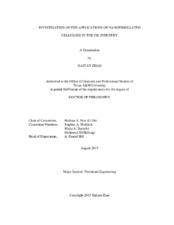| dc.description.abstract | Polymers, including biopolymers and synthetic polymers, are extensively used in oil industry. However, problems exist in these polymer fluids. Severe formation damage can be caused by most polymers. Moreover, thermal stability limits the applications of biopolymer-based fluids at high temperatures. Here, four nanofibrillated cellulose (NFC) have been evaluated as viscosifiers to prepare aqueous fluids, and compared to guar-based fluids.
The rheological properties and solid suspending ability of NFC-based fluids have been studied with the effects of temperature and salts. Formation damage of the new type of fluids in different formations has been evaluated. Degradation studies have been performed using different types of breakers.
The viscosity measurements have shown that the NFC-based fluids were stable as high as 350°F. For non-charged NFC, the fluids had a high tolerance to KCl and CaCl2. Moreover, NFC-based fluids had a good solid suspending ability, which out-performanced guar-based fluids. Coreflood tests were run using cores of different permeability. As for NFC-based fluids, the regained permeabilities were 85% or higher of the initial permeabilities in low-permeability cores, suggesting that NFC caused a slight damage. However, guar and HPG fluids caused much more damage than NFC fluids under same conditions. Severe damage was caused to high-permeability cores (about 400 md or more) when treated by NFC-based fluids. The damage degree was related to the size of NFC fibers. Fibers of smaller sizes can invade the core and plug the pore throats more easily. However, the new fluids were successfully degraded by different breakers, indicated by the significant decrease in the fluid viscosity. HPLC analyses have shown that the new viscosifiers can be mostly degraded into soluble products with low viscosity, which can be flowed back after the treatment.
This work has evaluated four nanofibrillated cellulose fibers as viscosifiers in fluids. These new fluids have better thermal stability and solid suspending ability than guar-based fluids under the same conditions. High regained permeability of low-permeability cores can be maintained when treated by the new fluids. Severe damage was caused in high-permeability cores, however, the damage can be removed because the fluids were degraded successfully. | en |


